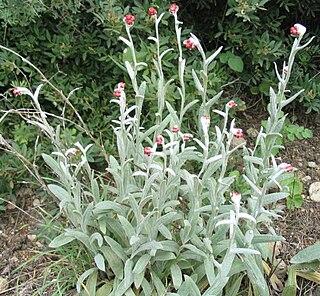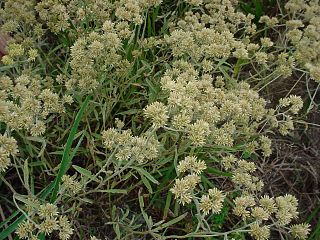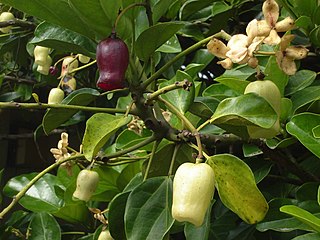
In taxonomy, binomial nomenclature, also called binominal nomenclature or binary nomenclature, is a formal system of naming species of living things by giving each a name composed of two parts, both of which use Latin grammatical forms, although they can be based on words from other languages. Such a name is called a binomial name, a binomen, binominal name or a scientific name; more informally it is also called a Latin name.

The genus Helichrysum consists of an estimated 600 species of flowering plants in the sunflower family (Asteraceae). The type species is Helichrysum orientale. They often go by the names everlasting, immortelle, and strawflower. The name is derived from the Greek words ἑλίσσω and χρῡσός.

Christian Horace Benedict Alfred Moquin-Tandon was a French naturalist and doctor.

Barthélemy Charles Joseph Dumortier was a Belgian who conducted a parallel career of botanist and Member of Parliament.

Achyrocline satureioides is a species of plant in the family Asteraceae. It is native to South America, from Argentina to Colombia to Guyana. A semi-annual herbaceous plant reaching about a meter tall, it has simple, narrow green leaves with serrated edges. It produces yellow flowers in racemes around Easter.
Achyrocline glandulosa is a species of flowering plant in the family Asteraceae. It is found only in Ecuador. Its natural habitat is subtropical or tropical moist montane forests. It is threatened by habitat loss.
Achyrocline hallii is a species of flowering plant in the family Asteraceae. It is found only in Ecuador. Its natural habitats are subtropical or tropical moist montane forests and subtropical or tropical high-altitude shrubland. It is threatened by habitat loss.
Achyrocline mollis is a species of flowering plant in the family Asteraceae. It is found only in Ecuador. Its natural habitat is subtropical or tropical moist montane forests. It is threatened by habitat loss.

Atuna is a genus of plants in the family Chrysobalanaceae described as a genus in 1838. It is native to the Indian Subcontinent, Southeast Asia, and various islands of the western Pacific.

Scleropyrum is a genus of trees in family Santalaceae first described as a genus in 1838. At present, only one species is recognized, although several others are listed as "unresolved," meaning that further research is needed to determine affinities.
Nomen illegitimum is a technical term, used mainly in botany. It is usually abbreviated as nom. illeg. Although the International Code of Nomenclature for algae, fungi, and plants uses Latin terms for other kinds of name, the glossary defines the English phrase "illegitimate name" rather than the Latin equivalent. However, the Latin abbreviation is widely used by botanists and mycologists.
Moquinia is a genus of flowering plants in the Moquinia tribe within the sunflower family.
Stenophalium is a genus of Brazilian plants in the tribe Gnaphalieae within the family Asteraceae.

Adenanthos barbiger, the hairy jugflower or hairy glandflower, is a species of shrub in the family Proteaceae. It is endemic to the south-west of Western Australia. It usually grows to 1 metre high, and has bright red flowers that appear mostly between August and December. The species was first formally described in 1839 by English botanist John Lindley in A sketch of the vegetation of the Swan River colony.
Campylostachys is a genus of flowering plants in the family Stilbaceae described as a genus in 1832.
Cordylogyne is a genus of plants in the family Apocynaceae, first described as a genus in 1838. It contains only one accepted species, Cordylogyne globosa, native to South Africa. Three other names have been proposed in the genus, also native to southern Africa, but at present they are listed as "unresolved," i.e., of uncertain affiliation.
- Cordylogyne argillicolaDinter - Namibia
- Cordylogyne kassnerianum(Schltr.) Eyles - South Africa
- Cordylogyne mossambicense(Schltr.) Eyles - Mozambique
Parapodium is a genus of flowering plants of the family Apocynaceae, first described as a genus in 1838. It is native to South Africa.
- Parapodium costatumE.Mey. - South Africa
- Parapodium crispumN.E.Br. - South Africa
- Parapodium simileN.E.Br. - South Africa

Pentarrhinum is a genus of plants in the family Apocynaceae, first described as a genus in 1838. It is native to Africa.
- Pentarrhinum abyssinicumDecne. - E + C + S Africa
- Pentarrhinum balense(Liede) Liede - Ethiopia
- Pentarrhinum coriaceumSchltr. - KwaZulu-Natal
- Pentarrhinum gonoloboides(Schltr.) Liede - Tanzania
- Pentarrhinum insipidumE.Mey. - South Africa
- Pentarrhinum ledermannii(Schltr.) Goyder & Liede - Burundi
- Pentarrhinum somaliense(N.E. Br.) Liede - Somalia
Rhyssolobium is a genus of flowering plants of the family Apocynaceae, first described as a genus in 1838. It contains only one known species, Rhyssolobium dumosum, endemic to South Africa.
Neobaclea is a monotypic genus of flowering plants belonging to the family Malvaceae. It only contains one known species, Neobaclea crispifolia(Cav.) Krapov.









